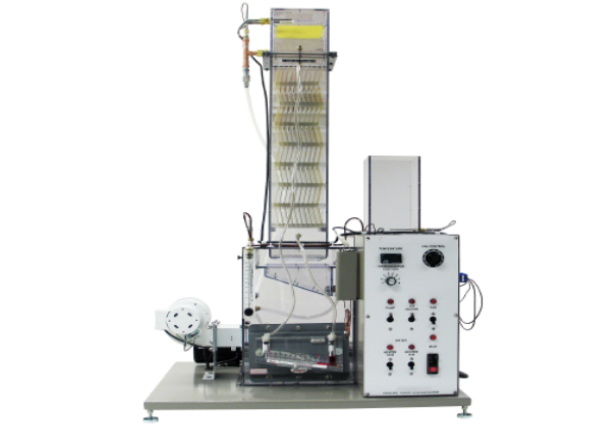Introduction
Cooling towers are the backbone of industrial and commercial heat rejection systems ensuring temperature regulation for processes in power plants, refineries, HVAC systems, food processing units, and manufacturing industries. However, the efficiency, longevity, and safety of these cooling towers are deeply dependent on the quality of water circulation and internal system health. Over time, factors like corrosion, scaling, microbial contamination, and inconsistent water chemistry can drastically affect cooling tower performance, causing reduced heat exchange efficiency, unplanned shutdowns, and excessive operational costs. To combat these challenges and maintain optimal performance, modern cooling towers rely on a suite of analytical equipment. These tools continuously monitor, measure, and control key operational parameters like water chemistry, flow rate, microbial growth, corrosion rates, and more.
Water Quality Analyzers (Multifunction Sensors)
Working Principle:
These sensors are installed either inline or in a sample stream line (side stream). They continuously measure various water quality parameters using electrochemical or optical techniques and transmit the data to a central controller.
Key Measured Parameters & Importance:
- pH (7.5–8.5 Ideal):
- Low pH (acidic) can corrode metals and degrade tower parts.
- High pH encourages scaling due to calcium carbonate precipitation.
- Conductivity:
- Indicates the ionic concentration in water, correlating with the total dissolved salts.
- Used for blowdown optimization to maintain cycles of concentration and reduce water wastage.
- TDS (Total Dissolved Solids):
- Affects scaling potential and efficiency of heat transfer.
- High TDS leads to deposition on tubes and fill media.
- ORP (Oxidation-Reduction Potential):
- Measures the sanitizing power of oxidizing agents.
- A key metric for microbial control in recirculating systems.
- Free/Total Chlorine or Bromine:
- Tracks disinfection levels.
- Ensures effective microbial killing while avoiding over-dosing that may damage components.
Advantages:
- Enables automatic chemical dosing.
- Reduces risks of corrosion, scaling, and biofouling.
- Saves labor and ensures continuous, real-time protection.
Corrosion Monitoring Systems
Types:
- Corrosion Coupons:
- Simple, low-cost method.
- Coupons are made from the same metal as system piping.
- Evaluated periodically to calculate weight loss and estimate corrosion rate.
- Electrical Resistance (ER) Probes:
- Real-time corrosion tracking.
- Detects minute changes in metal thickness by measuring electrical resistance changes.
Use Cases:
- Quantifies corrosion rates (in mils/year).
- Assesses performance of corrosion inhibitors.
- Detects early failure risks in metallurgy.
Benefits:
- Helps in predictive maintenance.
- Protects critical assets (condensers, piping, exchangers).
- Essential in systems exposed to aggressive water chemistry.
Biofilm Detection Sensors
Why It Matters:
Biofilms provide shelter for bacteria like Legionella, posing health risks and operational challenges. Biofilms also insulate heat transfer surfaces and promote corrosion.
Sensor Technologies:
- Thermal Probes:
- Detect thermal resistance caused by microbial slime.
- Heating elements measure how biofilm insulates the sensor.
- Optical/Ultrasound Probes:
- Monitor changes in light reflectivity or sound wave distortion.
- Useful in detecting growth on smooth surfaces.
Role in Operations:
- Alerts before biofilm becomes visible.
- Supports optimized biocide dosing, reducing chemical overuse.
- Prevents biological fouling in heat exchangers.
Dissolved Oxygen (DO) Meters
Functionality:
Measures oxygen saturation using:
- Electrochemical sensors (galvanic/polarographic) – reaction-based.
- Optical sensors – light-based, highly accurate and maintenance-free.
Why Monitor DO?
- High DO accelerates corrosion, especially of mild steel and copper.
- Low DO may reduce biocide effectiveness, especially for oxidizers like chlorine.
- Crucial in systems using deoxygenated or treated makeup water.
Operational Insight:
- Helps fine-tune corrosion inhibitor dosing.
- Identifies oxygen ingress in closed-loop or semi-open systems.
Flow Meters & Pressure Gauges
Flow Meters:
- Types: Paddlewheel (mechanical), electromagnetic, ultrasonic (non-intrusive).
- Ensure optimal water circulation across fill media and exchangers.
- Detect underflow (clogging) or overflow (pump inefficiency).
Pressure Gauges:
- Placed across pumps, filters, and exchangers.
- Identify clogging, fouling, or pump failure by measuring pressure drop.
Benefits:
- Maintains hydraulic balance.
- Supports energy efficiency by ensuring pumps run within design parameters.
- Prevents uneven distribution of cooling water.
Chemical Dosing Controllers
How They Work:
- Receive feedback from sensors like pH, ORP, and conductivity.
- Adjust dosing pumps automatically to maintain setpoints.
- Can manage multiple chemical types via separate dosing channels.
Controlled Chemicals:
- Biocides – control bacteria, algae, and fungi.
- Antiscalants – suppress scale formation by sequestering calcium/magnesium.
- pH Adjusters – use acids or alkalis to maintain balance.
Impact on System:
- Reduces manual workload.
- Prevents over/under-dosing.
- Increases chemical efficiency, saves cost and minimizes environmental footprint.
- Enhances system safety and regulatory compliance.
Scale Deposition Monitors
Functionality:
- Temperature Differential Probes: Detect insulation caused by scale build-up.
- Ultrasound Sensors: Measure impedance or density changes near heat exchange surfaces.
Importance:
- Scale lowers heat transfer efficiency, leading to higher energy use.
- Excessive scale can cause overheating and failure of critical components.
Integration:
- Works with chemical dosing systems.
- Automatically increases antiscalant feed when early scaling signs appear.
- Supports real-time preventive action.
Conclusion
Where downtime equals loss, maintaining peak operational performance of cooling towers is non-negotiable. Analytical equipment provides the intelligent backbone of cooling tower management — offering insights, control, and early warnings before minor issues become major failures. Whether it’s a simple corrosion coupon or a high-precision ORP sensor, each instrument plays a vital role in ensuring system cleanliness, heat transfer efficiency, and regulatory compliance. Automated data collection and dosing not only reduce human error but also optimize chemical usage, prolong equipment life, and enhance environmental sustainability.

